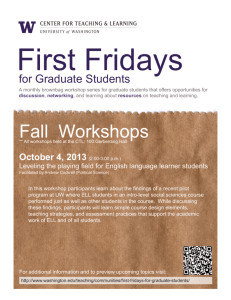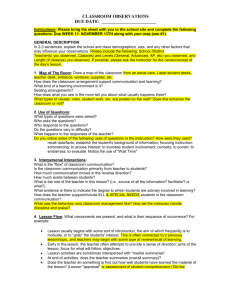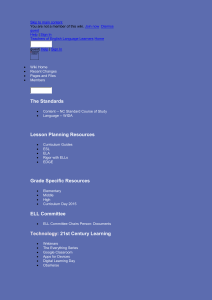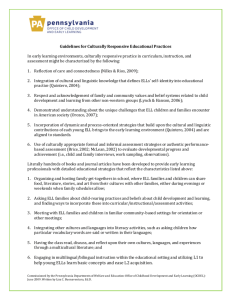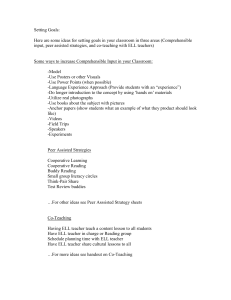Effects of ESOL Service-Learning Experience on
advertisement
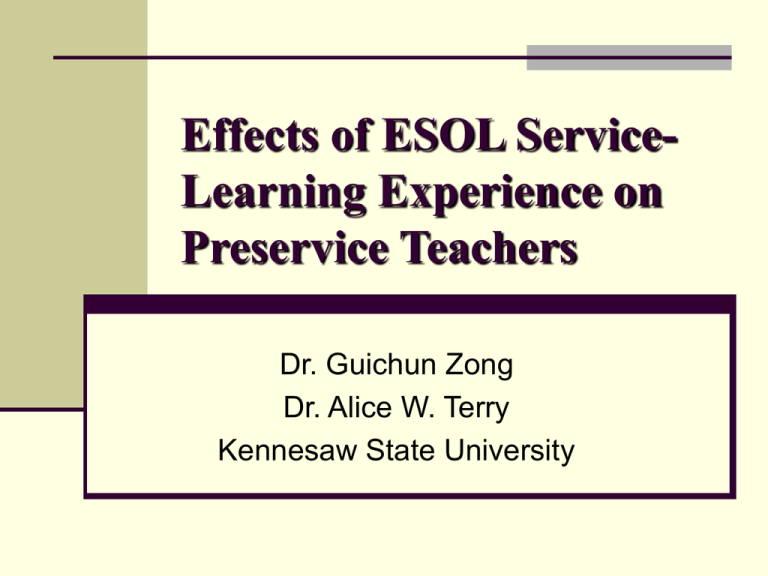
Effects of ESOL ServiceLearning Experience on Preservice Teachers Dr. Guichun Zong Dr. Alice W. Terry Kennesaw State University What is Service-Learning? “…an innovative teaching methodology that integrates community service with academic study to enrich learning, teach civic responsibility, and strengthen communities.” National Commission on Service-Learning, 2002 Description of Study 58 middle-grade-preservice teachers participated Performed 6-15 hours of tutoring to ELL’s in elementary schools Worked with Cobb County Schools Data Collected Pre/Post survey 2-4 page formal reflection ELL’s—English Language Learners •8000+ ESOL students from 131 countries •81 Major Languages •Mostly Hispanic students, many lacking native language literacy skills Cobb County School System Initial Research Questions What is the impact of the service-learning internship experience on middle grades TOSS preservice candidates concerning the knowledge about and attitudes toward ELL learners? How does the amount of time spent in the field experience impact the middle grades TOSS preservice candidates’ knowledge about ELL students, attitudes toward ELL students, and self-efficacy in teaching ELL students? Added Research Question: What is the effect of the experience on the English Language Learners (ELL’s) in the schools? Quantitative Data: Overview • Data Collection – Survey Instrument • 20 items • Attitude, efficacy, and knowledge – Pre-experience and post-experience survey • Data Analysis – Paired-sample T-tests Findings from Quantitative Analysis • T-test results item by item (Handout) • Directions of changes – Expected – Unexpected • Significance of changes • Knowledge-all gains in expected ELL students learn better if direction they are not allowed to use their native language at school 2.71 2.78 • Ell students should be expected to be fluent in English after one year of ELL Instruction. 2.51 2.61 • I don’t know how to instruct-interact with an ELL student in my class. 3.62 2.99 * • ESOL students should be put in special schools or classes until they have orally mastered the English language. ____________________ *Statistically significant at .05 level. 2.36 2.51 Knowledge-gains that is statistically significant • I don’t know how to instruct-interact with an ELL student in my class. Mean SD 3.62 1.34 Mean SD 2.99 1.13 Difference 0.63 p value .00* Efficacy-gain in expected direction • I am confident as a teacher working with ELL students. Pretest Mean 3.40 Posttest Mean 3.61 Attitudes: Changes in the Expected Directions Means Pre-test Post-test ____________________________________________________________________________________________________________________ It is necessary that all teachers modify their lesson plans for ELL students. 5.09 5.13 Adding ELL students to my class will increase my workload. 4.73 4.71 ELLs should be proficient in speaking English before joining mainstream classrooms. 3.62 ELL students bring needed diversity to schools. 5.04 3.38 5.27 It is the responsibility of ELL students to adapt to American culture and school life. 3.29 3.1 My first response to ELL students would be to give them separate work. 3.14 3.13 Attitudes: Changes confusing us Means Pre-test Post-test --------------------------------------------------------------------------------------------------------------------- I am eager to teach English language learners. 4.24 4.11 I would teach my subject to an exclusively ESOL class. 3.35 2.94* I am likely to complete the ESOL endorsement. 3.51 ELLs should remain in separate ESOL track during their time at our school. 2.33 If I have students in my classroom whose 1st language in not English, I will send him/her to the school’s ESOL teacher. 3.14 I don’t think that our school system should allow ELL students to participate/attend unless they can speak/understand English. 2.05 ___________________________________________________________ *Statistically significant at .05 level. 3.31 2.69* 3.52 * 2.2 Attitude: Changes that are statistically significant Pretest SD Posttest SD p-value ________________________________________ 3.35 1.37 2.94 1.29 .04 2.33 .904 2.69 1.27 .04 3.14 1.14 3.52 1.21 .05 I would teach my subject to an exclusively ESOL class. ELLs should remain in separate ESOL track during their time at our school. If I have students in my classroom whose 1st language in not English, I will send him/her to the school’s ESOL teacher. Qualitative Results: Emergent Themes 1. Opened My Eyes 2. Stares at Ceiling 3. Through the Looking Glass Opened My Eyes Their eyes were opened… As to how an elementary school operates To younger students To cultural aspects of schools To feeling what an ELL experiences To misconceptions concerning ELL’s “ ELL’s need to be validated” To the need to help ELL’s As to how frustrated teachers are in addressing the needs of ELL’s Opened My Eyes Before: some thought ELL’s should be immersed in English After: all conceded their minds had been changed School systems need more resources especially in regular classroom Best support system ELL’s had was each other Misconception: believing students don’t want to learn All recognized what a huge barrier language is in learning even if students speak English fluently Stares at Ceiling The ELL’s would stare off at the ceiling, “able to fade” The most used English phrase of the ELL’s, according to one participant, was, “I don’t know.” “I could see the blank stares on their faces.” Stares at Ceiling “The students are frustrated with learning and the teachers.” “He [ELL] would tune out and turn off.” “[Enrico] didn’t want to learn and nobody noticed.” Stares at Ceiling… What happened when the participants began interacting with the ELL’s is remarkable. Eyes left the ceiling and the ELL’s warmed up, sharing enlightening conversations, “lighting up” when asked about their own culture. Lewis Carroll’s Through the Looking Glass There are many mirror themes, including opposites, time running backwards, general confusion. Alice ponders what the world is like on the other side of a mirror. She discovers a book with looking-glass poetry, "Jabberwocky," which she can read only by holding it up to a mirror. Jabberwocky `Twas brillig, and the slithy toves Did gyre and gimble in the wabe: All mimsy were the borogoves, And the mome raths outgrabe. According to Alice, “Somehow it fills my head with ideas—only I don’t exactly know what they are!” Through the Looking Glass: What the TOSSers Saw The experience differed widely from school to school. Some TOSSers worked with the students in the regular classroom; some only in the ESOL classroom; some worked one on one with the students; others only were allowed to observe. Some worked with experienced tutors; others worked with inexperienced tutors. Some worked in schools with mostly Hispanic ELL’s; others worked in schools with more diverse ELL’s. Through the Looking Glass: What the TOSSers Saw Tutors worked on vocabulary development- point/flash cards (method). In schools with strong ESOL tutors, tutors provided connection to ELL’s culture and helps ELL’s adjust to challenges. Generally the TOSSers did not see much if any modification for students in regular classroom. They weren’t critical of the regular classroom teachers for the most part; they seemed to understand their frustration in dealing with the ELL’s. No differentiation or culturally-responsive teaching strategies in classroom. Students were immersed in English in regular classroom Through the Looking Glass: What the TOSSers Felt The TOSSers’ feelings ran the gamut, from positive and worthwhile to frustrating and discouraged. One student related that she was “torn over the experience.” TOSSers felt frustrated on many levels: finding the time to do the experience; getting set up in the schools Nervous about how ELL’s will succeed in their own classrooms one day. Through the Looking Glass: What the TOSSers Felt On the positive side, TOSSers found the experience worthwhile and beneficial. They enjoyed interacting with the ELL students. The experience promoted empathy and compassion in the TOSSers. For the most part, the students felt sad about leaving at the end of the experience; they were sad for the ELL’s and worried that they might not succeed. Through the Looking Glass: Impact of Experience on TOSSer The experience had mainly a positive impact on the TOSSers For a few there were negative influences. Concern about not having an impact on the ELL’s. Feeling unclear about the best way to teach ELL’s Feeling unequipped to help the students. Through the Looking Glass: Impact of Experience on TOSSer Expressions of having a positive impact were more prevalent. Will spend extra time helping ELL’s More familiar with how to break down information for ELL’s. Will modify things for ELL’s Some planned to learn Spanish and become ESOL certified. Through the Looking Glass: Impact of Experience on TOSSer Got over “little kid phobia” working with elementary students. Will incorporate culturally responsive things Positive about service-learning as a pedagogy. “Feel overwhelmed but encouraged and hopeful that I can reach any student!” Question: List a few things you know about ELL students Pre Survey Student 04 Response: They pick up oral language faster than written language Many live in homes where only one language is spoken Many are stereotyped (all Asians are smart, etc.) Post Survey Student 04 Response: ELL students are often frustrated in class ELL students are sometimes made fun of by their peers They have the hardest time writing in English They can often hear and speak English before they can write and read it They often have to translate questions/ directions in their head in their native tongue. Question: List any strategies you know that can help ELL’s in a classroom Pre Survey Student 35 Response: Using more diagrams or pictures that show step by step procedures Post Survey Student 35 Response: Explaining assignments to them one-on-one, rather than embarrassing them in front of the class Provide pictures and demonstrations to explain items more clearly Question: What factors do you think make an ELL ready to join mainstream classrooms? Pre Survey Student 10 Response: Some have ability to communicate the spoken and written language Desire and motivation to learn English Post Survey Student 10 Response: Passing certain ESOL checkpoints Improvement in English LA skills, i.e.. Spelling, speaking, writing, grammar Enthusiasm and desire to learn and improve Approval by ESOL supervisor teachers. Quantitative Results
